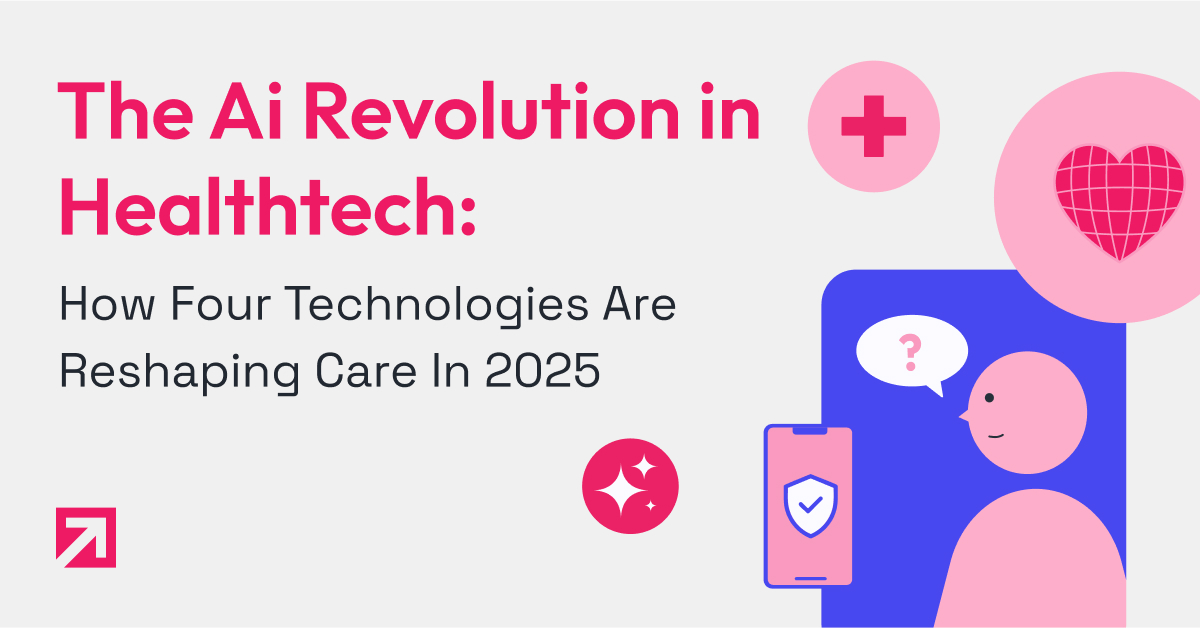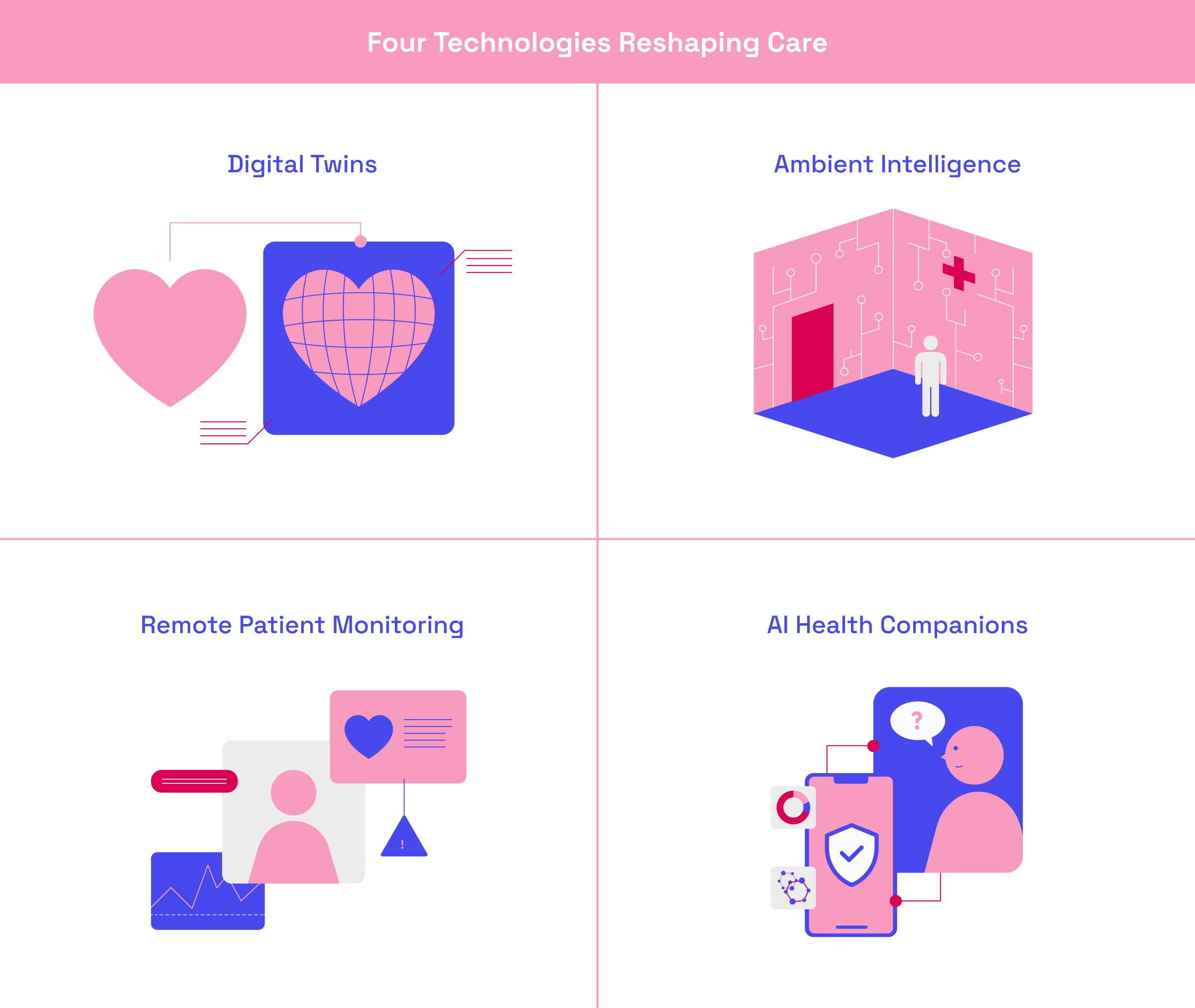
Strategy
The AI Revolution in Healthtech: How Four Technologies Are Reshaping Care in 2025

At Xmartlabs, we're witnessing a profound transformation as AI technologies move from theoretical potential to practical reality; four trends have emerged as key in reshaping healthcare in 2025.
Digital Twins: From Prediction to Prevention
A digital twin is a virtual model of a physical object, system, or process that uses real-time data to simulate, monitor, and optimize its real-world counterpart throughout its lifecycle. When they first came on to the scene, they were touted as a visualization tool providing digital models of a physical object, allowing researchers to test digitally how the physical version responded to different hypotheses.
Real-World Impact
- Advanced neurosurgical platforms are using technologies like NVIDIA Omniverse to create patient-specific brain models where surgeons can rehearse complex procedures in VR before entering the operating room, significantly reducing risks and improving recovery outcomes.
- Metabolic digital twins for diabetes patients integrate continuous glucose monitoring, dietary patterns, and genetic markers to predict individual responses to treatments with remarkable accuracy—essentially providing a personalized roadmap for care.
- Hospital command centers powered by digital twin technology are transforming operations by anticipating patient flow bottlenecks before they materialize, reducing emergency department wait times and optimizing resource allocation.
Ambient Intelligence: The Invisible Force Multiplier
While digital twins operate in the virtual realm, ambient intelligence systems are embedding AI directly into the clinical environment, quietly eliminating friction points that have frustrated clinicians for decades.
Beyond Documentation
- Advanced ambient documentation tools like Nuance's Dragon Ambient eXperience (DAX) are reducing documentation time dramatically at health systems nationwide, enabling physicians to see more patients while maintaining high satisfaction rates.
- Next-generation clinical AI now detects contextual cues in patient conversations, identifying potentially undiagnosed conditions by analyzing subtle speech patterns that humans often miss during routine visits.
- Smart monitoring systems in senior care facilities are achieving impressive accuracy in fall detection, reducing related emergency room visits and demonstrating that ambient intelligence delivers both safety and cost benefits.
The next frontier? "Phygital" clinics where ambient sensors create personalized environments based on patient biometrics and AI-powered behavioral analytics that can identify concerning patterns before visible symptoms appear.
As promising as these tools are, they also raise major ethical questions. Privacy-first and human-in-the-loop approaches will be critical to ensure that third parties do not use ambient data for nefarious purposes. At Xmartlabs, we prioritize data privacy and ethical usage of tech; we put people first.
Remote Patient Monitoring: From Data Collection to Predictive Intervention
Today's RPM systems have transcended basic vital sign tracking to become sophisticated early warning systems powered by predictive analytics.
Prevention Through Prediction
- AI-Enhanced RPM Initiatives at leading health systems don't just monitor heart failure patients; they can identify warning signs of health crises days before they occur, dramatically reducing readmissions and creating substantial cost savings.
- Virtual hospital programs are treating thousands of patients monthly through RPM kits, with AI helping to triage alerts so nurses can focus on high-risk cases. The outcome? Reduced transfers to higher levels of care and lower costs compared to traditional hospitalization.
What makes modern RPM truly transformative is how it's overcoming traditional adoption barriers. Device-agnostic platforms that integrate data from numerous wearable and contactless monitoring systems can monitor vital signs without requiring patients to wear additional devices.
AI Health Companions: Creating a Continuous Care Experience
The most visible face of AI in healthcare may be the intelligent companions that are extending clinical reach beyond facility walls. These tools are evolving rapidly, with privacy and data ownership emerging as critical differentiators in the market.
Intelligence with Empathy and Privacy
The next generation of AI health companions addresses several interconnected challenges:
- Privacy-first architecture is becoming essential. It embeds privacy protections directly into the design of systems rather than treating them as an afterthought. This approach not only ensures compliance with regulations like HIPAA and GDPR, but it also builds patient trust and reduces the risk of breaches.
- Natural language interfaces are transforming accessibility. Advanced companions now allow users to ask health questions in plain language and receive clinically accurate answers, functioning like supportive health educators rather than replacements for medical professionals.
- Data unification capabilities are solving fragmentation problems. By consolidating scattered health information into secure, portable profiles while integrating with healthcare standards like HL7 and FHIR, these platforms are creating a more coherent experience for clinicians and for their patients.
These privacy-preserving approaches don't compromise functionality. In fact, they enhance trust, which drives adoption and engagement. At Xmartlabs, our work on XLCare demonstrates how on-device processing can keep sensitive health information strictly on the user's device. This approach fundamentally rebalances data ownership, putting health insights back in patients' hands.
The Broader Impact of AI Health Companions
These evolving platforms are addressing critical healthcare gaps:
- Advanced symptom assessment systems are achieving impressive diagnostic accuracy across thousands of conditions, reducing unnecessary specialist referrals
- Adaptive communication technologies modify interactions based on a patient's health literacy level, meaningfully improving treatment adherence
- Predictive health modeling is identifying risk factors and early biomarkers for serious conditions years before clinical symptoms appear
For healthtech innovators, the most significant opportunity lies in addressing the privacy and integration challenges that have historically limited adoption. By processing data on-device and creating seamless handoffs between digital and human providers, the industry is building bridges necessary for AI companions to fulfill their transformative potential.

The Self-Reinforcing Healthcare Ecosystem
The true power of these technologies emerges when they intersect:
- Digital twins inform AI companions with personalized physiological models, enabling hyper-targeted recommendations.
- Ambient sensors feed real-time behavioral data into RPM systems, enhancing predictive accuracy.
- AI orchestration ties these elements together, allowing health systems to shift from episodic care to continuous health management.
The Xmartlabs Advantage: Building the Connected Future
At Xmartlabs, we're helping healthtech leaders navigate this complex landscape. Our expertise in AI integration, secure data architecture, and user-centered design positions us as the ideal partner for organizations ready to move beyond point solutions to a truly connected healthcare ecosystem.
The organizations that will thrive in this new landscape aren't just adopting individual technologies, they're reimagining care delivery around a continuous, AI-enhanced experience that begins long before symptoms appear and extends well beyond traditional episodes of care.
The future belongs to the integrated. Is your organization ready?

